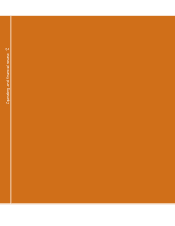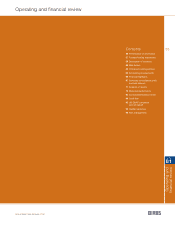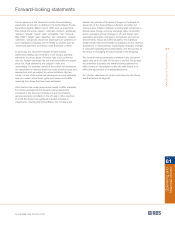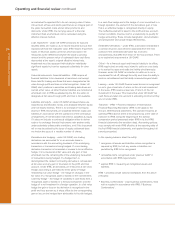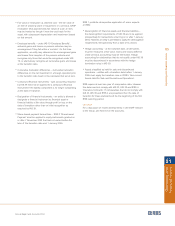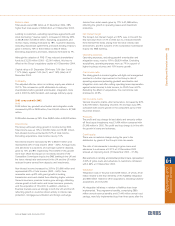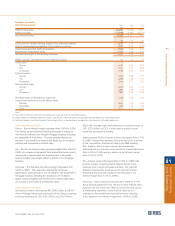RBS 2004 Annual Report Download - page 64
Download and view the complete annual report
Please find page 64 of the 2004 RBS annual report below. You can navigate through the pages in the report by either clicking on the pages listed below, or by using the keyword search tool below to find specific information within the annual report.
62
Operating and financial review
Operating and financial review continued
Securities carried at fair value include government, asset-
backed and corporate debt obligations and corporate equity
shares. Fair value for a substantial proportion of these
instruments is based on observable market prices or derived
from observable market parameters. Determining fair value for
such instruments does not involve significant judgement.
Where observable prices are not available or if a position
could be liquidated only at an unfavourable price or over an
extended period, fair value is based on appropriate valuation
techniques or management estimates.
The Group’s derivative products include swaps, forwards, futures
and options. Exchange traded instruments are valued using
quoted prices. The fair value of over-the-counter instruments is
derived from pricing models which take account of contract
terms, including maturity, as well as quoted market parameters
such as interest rates and volatilities. Most of the Group’s
pricing models do not entail material subjectivity because the
methodologies utilised do not incorporate significant judgement
and the parameters included in the models can be calibrated
to actively quoted market prices. Values established from pricing
models are adjusted for credit risk, liquidity risk and future
operational costs.
A negligible proportion of the Group’s trading derivatives are
valued directly from quoted prices, the majority being valued
using appropriate valuation techniques. The fair value of
substantially all securities positions carried at fair value is
determined directly from quoted prices.
General insurance claims
The Group makes provision for the full cost of settling
outstanding claims arising from its general insurance business
at the balance sheet date, including claims estimated to have
been incurred but not yet reported at that date and claims
handling expenses. Claims are recognised in the accounting
period in which the loss occurs.
Provisions are determined by management based on
experience of claims settled and on statistical models which
require certain assumptions to be made regarding the
incidence, timing and amount of claims and any specific
factors such as adverse weather conditions. In order to
calculate the total provision required, the historical
development of claims is analysed using statistical
methodology to extrapolate, within acceptable probability
parameters, the value of outstanding claims at the balance
sheet date. Also included in the estimation of outstanding
claims are other assumptions such as the inflationary factor
used for bodily injury claims which is based on historical
trends and, therefore, allows for some increase due to changes
in common law and statute. Costs for both direct and indirect
claims handling expenses are also included. Outward
reinsurance recoveries are accounted for in the same
accounting period as the direct claims to which they relate.
The outstanding claims provision is based on information
available to management and the eventual outcome may vary
from the original assessment. Actual claims experience may
differ from the historical pattern on which the estimate is based
and the cost of settling individual claims may exceed that assumed.
Goodwill
The Group capitalises goodwill arising on the acquisition of
businesses, as disclosed in the Accounting policies. Goodwill
is the excess of the cost of an acquisition and the fair value of
its net assets. The determination of the fair value of assets and
liabilities of businesses acquired requires the exercise of
management judgement; for example those financial assets
and liabilities for which there are no quoted prices, and those
non-financial assets where valuations reflect estimates of
market conditions such as property. Different fair values would
result in changes to the goodwill arising and to the post-
acquisition performance of the acquisition. Under UK GAAP
goodwill is amortised and there is a rebuttable presumption
that the useful economic life of purchased goodwill does not
exceed 20 years from the date of acquisition. The useful
economic life of acquired goodwill is assessed on the basis of
the type and diversity of the business, its location and the
markets in which it operates. Under US GAAP goodwill is not
amortised but is subject to annual review for impairment.
An impairment test is designed to assess the recoverable
amount of an asset or, in the case of goodwill, an operating
segment, by comparing its carrying value with the discounted
value of future cash flows that it will generate. Impairment
testing inherently involves a number of judgmental areas: the
preparation of cash flow forecasts for periods that are beyond
the normal requirements of management reporting, the
valuation of the separable assets of each business whose
goodwill is being reviewed and an assessment of the discount
rate appropriate to the business. Under UK GAAP, impairment
tests are only undertaken in the year following an acquisition or
when there is evidence that impairment might have occurred.
US GAAP requires annual impairment tests that are different
from any UK tests and accordingly they may support a different
carrying value for the asset being tested.




